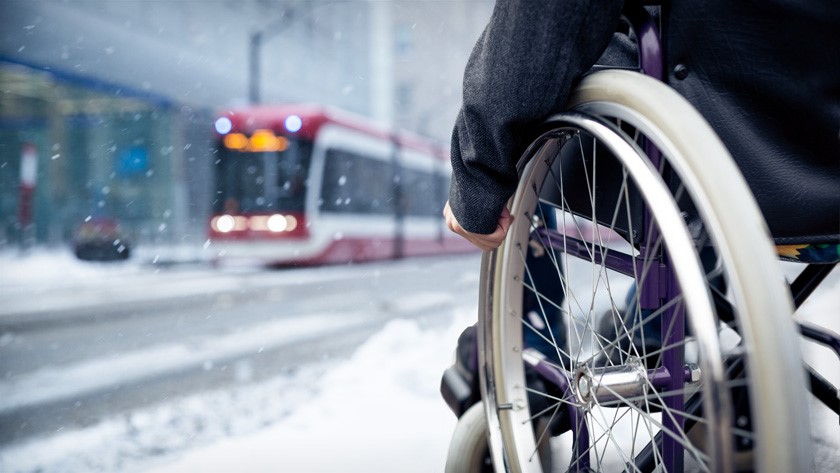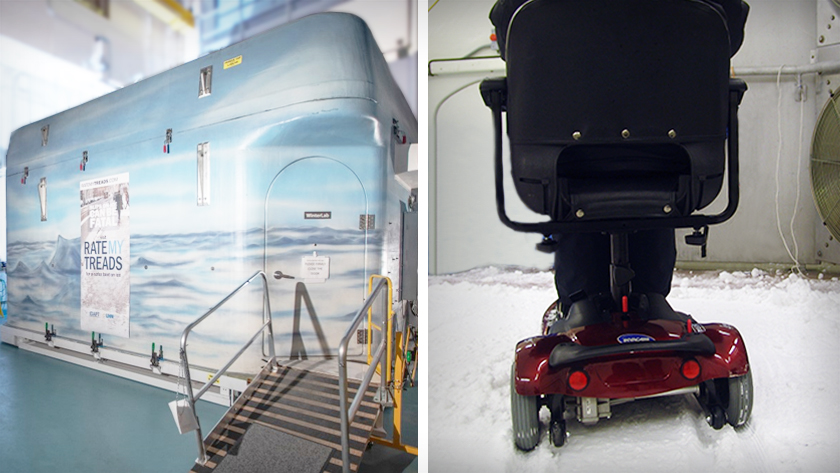
Although mobility scooters can offer invaluable independence and freedom, these benefits can be cut short by winter weather conditions.
A new study from UHN’s KITE Research Institute reveals that mobility scooters perform poorly under the snow- and ice-covered road conditions that are common during Canadian winters.
The research team tested the performance of eight commercially available mobility scooters under a range of winter driving conditions. “We tested performance in normal conditions on dry concrete, as well as on snow- and ice-covered surfaces. Specifically, we looked at the scooters’ steerability—the ability to round corners on level ground—and slip resistance when driving forward and backward on slopes,” says Dr. Geoffrey Fernie, senior author of the study and KITE Senior Scientist.
All scooters had near-perfect success rounding corners on a concrete surface, but when ice- and snow-covered surfaces were tested, around two out of three scooters failed.
Snow and ice also reduced the ability of scooters to navigate slopes. Only half of the scooters tested could ascend a gentle slope (i.e., a 4.8° incline) covered in snow without losing traction. Furthermore, only one scooter could ascend a slope that was covered in ice. The impact of snow and ice on slip resistance was even more apparent when the scooters descended slopes.
The inability of scooters to navigate a 4.8° slope in the presence of snow or ice is particularly concerning because this slope angle complies with the standards set out by the Americans with Disabilities Act.
“Snow removal services do not always adequately clear ramps and sidewalks, and many do not even clear snow until it accumulates to well over the amount that we tested,” warns Roger Montgomery, Research Analyst at the Toronto Rehabilitation Institute and lead author of the study. “Moreover, curb and accessibility ramps do not always comply with guidelines and are often much steeper.”
Given the failure of the scooters to maintain traction on snow- and ice-covered slopes, the team tested whether winter tires could improve scooter performance. Compared to stock tires, prototype winter tires significantly improved scooters’ performance, enabling them to successfully drive down 4.8° slopes covered in bare and melting ice.
Unfortunately, winter tires are not readily available for mobility scooters at this time.
“We need to improve safety for those facing mobility challenges—ensuring that they have the resources necessary to maintain their independence is a big part of that,” says Montgomery. “To meet the needs of scooter users year round, manufacturers need to consider winter environments when they design and test their devices, and make winter tires widely available.”
This work was supported by the Canadian Institutes of Health Research, the Natural Sciences and Engineering Research Council of Canada and the UHN Foundation. Two scooters used for winter tire testing were donated by Shoppers Home Healthcare.
Montgomery RE, Li Y, Dutta T, Holliday PJ, Fernie GR. Quantifying Mobility Scooter Performance in Winter Environments. Arch Phys Med Rehabil. 2021 Jul 5. doi: 10.1016/j.apmr.2021.06.005.

Dr. Geoffrey Fernie (L) is a Senior Scientist at KITE. Roger Montgomery (R) is a Research Analyst on the Toronto Rehabilitation Institute’s Home and Community Team.

(L) The Winter Lab at the KITE Research Institute can safely simulate Canadian winter conditions, including sub-zero temperatures and snow- and ice-covered surfaces. (R) Photograph of a mobility scooter driving on a snow-covered surface in the Winter Lab. Click here for a virtual tour of the Winter Lab.




